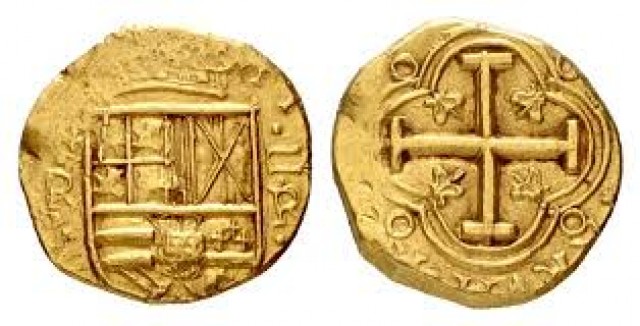
Publié à 4th Oct 2009
Modifié à 13th Mar 2018
Systèmes monétaires complexes
De nos jours, il est si simple de calculer une transaction de la vie quotidienne. Chaque pays possède une monnaie nationale, avec des noms différents mais fondamentalement les mêmes unités, et éventuellement une subdivision, comme un penny pour une livre ou un cent pour un dollar, généralement 1/100. Mais c'était une époque où le système monétaire était bien plus compliqué qu'une simple division par 100.

Par exemple, si vous devez payer un dollar et 39 cents, vous savez que vous pouvez donner 5 pièces de 25 cents et recevoir en retour un cent et une pièce de 10 cents. Ou vous pouvez donner deux dollars et recevoir 1 demi-monnaie et deux pièces de 5 cents et une pièce de 1 cent…
Les Grecs avaient un système beaucoup plus compliqué. La monnaie était le talant, une unité de poids d'environ 26 à 28 kilogrammes…
Normalement, il n'existe pas de pièces de ce type… mais quand on va acheter quelque chose, on utilise la subdivision. Un talant équivaut à 60 « mines » et chaque mine à 100 drachmes. La drachme était une pièce de monnaie d'environ 4,5 grammes, selon les normes normales. Et elle était également divisée en 6 oboles, ou 3 demi-oboles, ou 2 tiers d'oboles. Et bien sûr, la drachme d'argent n'était pas égale à la drachme d'or. Compliqué ? Pas comme à l'époque romaine…
Achetez maintenant pour 10 $ de réduction sur votre premier achat
Les Romains utilisaient un rapport argent-or. Un aureus correspondait à 1/72 du poids de l'unité de mesure monétaire standard, la « livre ».
Elle équivalait à 25 deniers, frappés en argent. Bien entendu, on frappait des demi-deniers et des demi-aurei.
Un denier valait 4 sesterces de cuivre et un sesterce valait 2 dupondius ou 4 ass. L'as et le dupondius avaient la même taille mais sur le dupondius l'empereur portait une couronne radiée et non des lauriers. Un as était également divisé en 2 semis ou 4 quadrans. Ainsi, un aureus = 25 deniers = 100 sesterces = 200 dup as = 800 semis = 1600 quadrans. Simple ? Essayez de calculer combien d'aureus vous possédez si vous possédez 47 as de cuivre...
Dans la France médiévale, la pièce la plus précieuse était le « louis d'or ». Il était fabriqué en or et comportait plusieurs moitiés ou doubles louis… il était divisé en 4 écus, frappés en argent et chaque écu équivalait à 6 livres en argent. Une livre équivalait à 20 sols et chaque sol équivalait à 12 deniers. Mais elle équivalait également à 4 liards, donc le rapport liards:deniers était de 1:3
Ou plus simple
1 louis d'or=4 écus=24 livres=480 sols=1920 liards=5760 deniers.
Pas de problème, mais seulement si vous n'avez pas à travailler avec des pièces toute la journée et à rendre la monnaie…
En Grande-Bretagne, le système était à peu près le même. Une livre équivalait à 20 shillings, chaque shilling à 12 pence et chaque pence à 3 farthings. Une livre équivalait donc à 240 pence ou 720 farthings…
La Russie avait un problème similaire. Un rouble était fabriqué à partir d’argent. Il équivalait à 2 poltiniks (« la moitié »), chaque poltinik équivalait à polupoltinic (« la moitié de la moitié »). Un poltinic équivalait à cinq grivnas. Une grivna équivalait à 3 altins et un kopek et chaque kopek équivalait à deux denghi (« argent ») ou 4 polushkas.
Pierre le Grand se rendit compte que le système était trop compliqué et décida de prendre le rouble et le kopeck comme nouvelles unités, dans un rapport de 1:100. Ainsi, un poltinik valait 50 kopecks, un polupoltinik 25, une grivna 10, une altin 3, et un denghi ½ tandis que la polushka valait ¼ de kopeck.
Désormais, en remplaçant le nom d'une pièce par un chiffre, tout est devenu plus simple et bientôt, tous les pays du monde ont adopté le système de subdivision.
Stéphane Vasilita
Rechercher le Coin Encyclopedia
Derniers articles
Les gros cents sont des pièces de cuivre d'un cent, frappées de 1793 à 1857, parmi les premières pièces officielles américaines. Parmi les types les plus connus, on trouve les couronnes et les chaînes. Découvrez les types, la valeur et l'histoire des gros cents !
11th Jul 2025
Les jetons Hard Times sont des pièces non officielles créées par des entreprises privées américaines pendant la dépression économique des années 1830. Découvrez l'histoire, les designs rebelles et la valeur des jetons Hard Times ici !
18th Jun 2025
Les dollars présidentiels sont des pièces de monnaie américaines représentant chaque ancien président décédé, émises entre 2007 et 2020. Découvrez le contexte, les détails et les précieuses variétés de dollars présidentiels dans ce guide.
5th Jun 2025
Catégories d'articles
Collection of articles providing lots of useful information on coins through the ages.
30 les articles
Articles and Resources relating to general coins collecting subjects.
7 les articles


